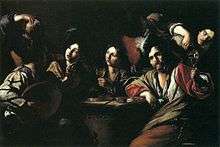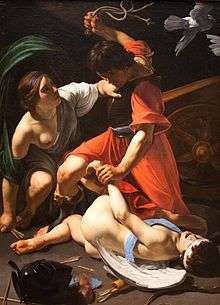Bartolomeo Manfredi
Bartolomeo Manfredi (baptised 25 August 1582 – 12 December 1622) was an Italian painter, a leading member of the Caravaggisti (followers of Michelangelo Merisi da Caravaggio) of the early 17th century.
Bartolomeo Manfredi | |
|---|---|
 Tavern Scene with a Lute Player by Bartolomeo Manfredi | |
| Born | August 25, 1582 |
| Died | December 12, 1622 (aged 40) |
| Nationality | Italian |
Life
Manfredi was born in Ostiano, near Cremona. He may have been a pupil of Caravaggio in Rome: at his famous libel trial in 1603 Caravaggio mentioned that a certain Bartolomeo, accused of distributing scurrilous poems attacking Caravaggio's detested rival Baglione, had been a servant of his. Certainly the Bartolomeo Manfredi known to art history was a close follower of Caravaggio's innovatory style, with its enhanced chiaroscuro and insistence on naturalism, with a gift for story-telling through expression and body-language.
Caravaggio in his brief career — gaining fame in 1600, exiled from Rome in 1606, and dead by 1610 — had a profound effect on the younger generation of artists, particularly in Rome and Naples. And of these Caravaggisti (followers of Caravaggio), Manfredi seems in turn to have been the most influential in transmitting the master's legacy to the next generation, particularly with painters from France and the Netherlands who came to Italy. No documented, signed works by Manfredi survive, and several of the forty or so works now attributed to him were formerly believed to be by Caravaggio. The steady disentangling of Caravaggio from Manfredi has made clear that it was Manfredi, rather than his master, who was primarily responsible for popularising low-life genre painting among the second generation of Caravaggisti.
Manfredi was a successful artist, able to keep his own servant before he was thirty years old, "a man of distinguished appearance and fine behaviour" according to the biographer Giulio Mancini, although seldom sociable. He built his career around easel paintings for private clients, and never pursued the public commissions upon which wider reputations were built, but his works were widely collected in the 17th century and he was considered Caravaggio's equal or even superior. His Mars Chastising Cupid offers a tantalising hint at a lost Caravaggio: the master promised a painting on this theme to Mancini, but another of Caravaggio's patrons, Cardinal Francesco Maria Del Monte, had taken it, and Mancini therefore commissioned Manfredi to paint another for him, which Mancini considered Manfredi's best work.
Manfredi died in Rome in 1622. Gerard Seghers (or Segers; 1589–1651) was one of his pupils.[1][2]
Gallery
 Mars Chastising Cupid, Art Institute of Chicago. Once attributed to Caravaggio, a typical Caravaggesque painting of the type popularised by Manfredi
Mars Chastising Cupid, Art Institute of Chicago. Once attributed to Caravaggio, a typical Caravaggesque painting of the type popularised by Manfredi.jpg) Cain Kills Abel, oil painting by Bartolomeo Manfredi, c. 1600, Kunsthistorisches Museum (Vienna)
Cain Kills Abel, oil painting by Bartolomeo Manfredi, c. 1600, Kunsthistorisches Museum (Vienna) Apollo and Marsyas, oil painting by Bartolomeo Manfredi, 1616-1620, Saint Louis Art Museum
Apollo and Marsyas, oil painting by Bartolomeo Manfredi, 1616-1620, Saint Louis Art Museum Caesar's Tribute, c. 1610-20, Uffizi
Caesar's Tribute, c. 1610-20, Uffizi.jpg) Soldier with the head of St. John the Baptist[3]. Prado Museum, Madrid
Soldier with the head of St. John the Baptist[3]. Prado Museum, Madrid
References
- Hobbes, James R. (1849). Picture collector's manual adapted to the professional man, and the amateur. T&W Boone, 29 Bond Street; Digitized by Googlebooks. p. 43.
- Gerard Seghers and the 'Denial of St Peter' , Benedict Nicolson. The Burlington Magazine (1971); pages 302, 304-309.
- "Soldado portador de la cabeza del Bautista - Colección - Museo Nacional del Prado". www.museodelprado.es. Retrieved 2020-03-26.
Further reading
- Peter Robb, "M" (1998) ISBN 0-312-27474-2 ISBN 0-7475-4858-7
- Helen Langdon, "Caravaggio: A Life" (1998) ISBN 0-374-11894-9
- Farquhar, Maria (1855). R.N. Wornum (ed.). Biographical catalogue of the principal Italian painters, by a lady. Woodfall & Kinder, Angel Court, Skinner Street, London. p. 94.
- Gash, John (March 2016). "Bartolomeo Manfredi's St John the Baptist and its Mezzotint". Print Quarterly. XXXIII (1): 11–18.
External links
| Wikimedia Commons has media related to Bartolomeo Manfredi. |
- Orazio and Artemisia Gentileschi, a fully digitized exhibition catalog from The Metropolitan Museum of Art Libraries, which contains material on Bartolomeo Manfredi (see index)
- Web Gallery of Art
- Dayton Art Institute